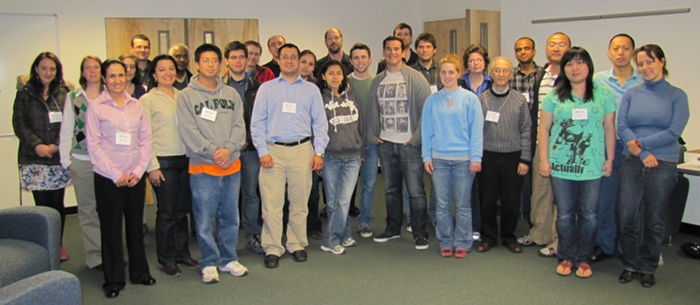| Description | Central Theme | Participants | Agenda (pdf) | Products |
|---|
NIMBioS Tutorial: Multi-cell, Multi-scale Modeling

Topic: Towards Virtual Tissues – Multi-cell, Multi-scale Modeling using CompuCell3D and SBML
Meeting dates: May 18-21, 2011
Location: NIMBioS at the University of Tennessee, Knoxville
Organizers/Presenters:
James A. Glazier
(Director, Biocomplexity Inst.; Dept. of Physics, Indiana Univ.)
Maciej Swat (Biocomplexity Institute, Indiana Univ.)
James Sluka (Senior Scientist, Biocomplexity Inst., Indiana Univ.)
Randy Heiland (Research Scientist, Open Systems Lab, Indiana Univ.)
Herbert Sauro (Dept. of Bioengineering, Univ. of Washington)
Julio Belmonte (Graduate Student, Biocomplexity Institute, Indiana Univ.)
Dimitrij (Mitja) Hmeljak (Computer Science, Indiana Univ.)
Objectives: This tutorial introduced and taught a novel, state-of-the-art approach to multi-cell multi-scale modeling using the Glazier-Graner-Hogeweg (GGH) and reaction kinetics network models and the CompuCell3D (CC3D) and Systems Biology Markup Language (SBML) simulation environments. CC3D is an Open-Source package (www.compucell3d.org) which allows researchers to build, test and run sophisticated multi-cell, multi-scale models of tissues and organs without low-level coding, while the Systems Biology Workbench (SBW) and SOSLib suite of tools provide similar functionality for subcell modeling. Together these tools provide flexibility similar to MATLAB or Mathematica, but with a biological focus and interoperate using simple integration calls. During the tutorial, we introduced the mathematical foundations of both models and walked participants through a series of examples of increasing biological and mathematical complexity. We taught Python scripting, which allows users to build highly complex biomedical simulations integrating both toolkits. By the conclusion of the tutorial, participants learned the skills needed to build models of, e.g. vascularized tumor growth, segmentation in vertebrate embryos or limb bud development. Attendees were encouraged to work on models of their own research systems and received assistance from the organizers and presenters.
For additional information about the central theme of the tutorial, click here.
Tutorial Organization: The tutorial included lectures and hands-on tutorials. We introduced basic network dynamics, SBML, GGH and CC3D concepts early in the tutorial to give users a chance to start exploring and building simple models (oscillators, switches, cell sorting, simple chemotaxis, etc.) as early as possible. We then discussed more advanced features and gradually moved towards building more complex models, which involved many subcellular components, diffusion fields and interactions between cells and diffusants. We taught Python scripting and reviewed state-of-the-art multi-scale, multi-cell models published in literature. Using Python scripting to connect CC3D to SOSLib, participants used complex biochemical networks to control the behaviors of each cell in their simulations. We walked participants through the process of reconstructing models found in literature and teach analytic approaches to building new models. Finally, we worked one-on-one with participants on implementation their models. We also demonstrated how to extend the modeling environments using C++ plugins and teach how to translate parameters found in the literature into model parameters.
Each participant also presented a short-format talk on their multi-cell modeling and experimental experience, interest and goals. The aim of these talks was to help identify common interests among participants, jump-start new collaborations and refine participants’ ideas concerning model development.
By the end of this intensive course, participants should have been able to build, test and analyze multi-cell, multi-scale biomedical models. To further assist participants with building new models, we provided over 50 demonstration models as part of the standard CC3D installation and 230 models with SBML.
We also had a set of discussion sessions to address perceived needs in SBML/CC3D and multi-cell modeling more generally, so that the community of modeling software developers could receive feedback from current and potential users to guide their development strategies. We were particularly eager to engage the participation of developers of other multi-cell frameworks to explore integration strategies with the SBML/CC3D core.
The Program for Excellence & Equity in Research (PEER) at the University of Tennessee was a co-sponsor of this tutorial. PEER was created to increase the number of accomplished, competitive, and determined underrepresented minority students who pursue Ph.D.s in the sciences, attain careers in biomedical research, and contribute to our nation's well being. For more information on PEER, visit http://web.utk.edu/~peer/.
Evaluation report (PDF)
Products
Publications
Bravo R, Axelrod D. 2013. A calibrated agent-based computer model of stochastic cell dynamics in normal human colon crypts useful for in silico experiments. Theoretical Biology and Medical Modelling, 10: 66. [Online]
Presentations
Axelrod DE. 13-17 April 2015. Stem Cell Dynamics in Normal Human Colon Crypts and the Initiation and Therapy of Colon Caner. Workshop on Stem Cells, Development, and Cancer, Mathematical Biology Institute, Ohio State University, Columbus, OH.
Grants/Proposals
Swat M, Glazier J. Sauro H, Stern C, Grabe N, Merks, R, Jacinto A. 2012-2014. QuantTissue.eu. 20,000 Euros per year for three years. Accepted.
Meetings, Workshops, & Symposiums
Swat M, Glazier J, Sauro H, Heiland R. August 2011. Developing biomedical simulations using CompuCell3D and SBW, Indiana University, Bloomington, IN.
Education
Glazier J. 2012. Class: Evolution in Cancer.
Software, Data, & Websites
Bravo R, Axelrod DE. 2014. VirtualCryptModel020413G: Agent-Based computational model of the colon crypt: Development of a virtual crypt for in-silico experiments. NetLogo Community Models Repository. [Online]
Swat M, Belmonte J, Hmeljak M, Heiland R, Sauro H et al. 2012. www.compucell3d.org
A goal of NIMBioS is to enhance the cadre of researchers capable of interdisciplinary efforts across mathematics and biology. As part of this goal, NIMBioS is committed to promoting diversity in all its activities. Diversity is considered in all its aspects, social and scientific, including gender, ethnicity, scientific field, career stage, geography and type of home institution. Questions regarding diversity issues should be directed to diversity@nimbios.org. You can read more about our Diversity Plan on our NIMBioS Policies web page. The NIMBioS building is fully handicapped accessible.
NIMBioS
1122 Volunteer Blvd., Suite 106
University of Tennessee
Knoxville,
TN 37996-3410
PH: (865) 974-9334
FAX: (865) 974-9461
Contact NIMBioS


